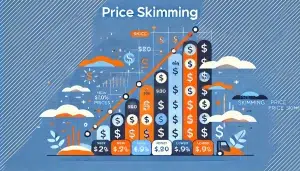Staying on top of the latest pricing trends is no longer a luxury. In 2024, it’s a necessity.
As the ecommerce landscape continues to evolve at a rapid pace, pricing strategies have become increasingly crucial for businesses looking to stay ahead of the competition.
Understanding these markets and harnessing the pricing trends making waves this year is vital. This comprehensive article delves into key pricing trends in 2024 that will shape the ecommerce industry, equipping you with the insights and strategies you need.
The Rise of Dynamic Pricing – Market Fluctuations
The concept of dynamic pricing has emerged as a powerful tool for businesses to stay agile and responsive to market conditions. This pricing strategy involves continuously adjusting prices based on a multitude of factors, including demand, supply, competitor prices, and seasonal trends.
Pioneered by industry giants like Amazon, dynamic pricing has become a hallmark of successful ecommerce operations, allowing businesses to capitalize on shifting market dynamics and maximize profitability.
With advanced algorithms and machine learning, utilizing this pricing trend can analyze vast amounts of data to suggest optimal prices.
The Pricing Trend of Automation: Streamlining
Pricing trends in 2024 is all about AI-powered pricing strategies as they continue to become more sophisticated. By leveraging advanced software and algorithms, ecommerce retailers can streamline their pricing processes, freeing up valuable time and resources to focus on strategic initiatives and long-term growth.
Competitor Price Tracking
One of the primary applications of automation in ecommerce is the ability to continuously monitor and track competitor pricing. Automated tools can systematically gather and analyze data on price movements across the industry, providing real-time insights that inform their own pricing decisions. This level of agility and responsiveness is essential in the fast-paced world of online retail.
Predictive Pricing
Beyond just tracking current market conditions, automation can also forecast future pricing trends and sales volumes. By analyzing historical data and leveraging predictive analytics, these automated systems can generate valuable insights that help businesses optimize their inventory management, shipping logistics, and overall pricing strategies.
Personalized Pricing
This involves tailoring prices based on individual customer behavior, preferences, and purchase history. This approach can significantly boost customer loyalty and sales, as it makes customers feel valued and understood.
It could mean offering special discounts to loyal customers, providing personalized offers based on browsing history, or even adjusting prices based on the time of day a customer is shopping.
Subscription Models
These have have been around for a while, but their popularity is set to soar in 2024. Consumers are increasingly looking for convenience and value, and subscription services offer both. Whether it’s for consumable goods, or for access to exclusive content and services, subscriptions provide a steady revenue stream and build customer loyalty.
To capitalize on this pricing trend, ecommerce businesses should consider offering subscription options for their products. This not only ensures recurring revenue but also helps in predicting future sales more accurately. Pricing for subscriptions should strike a balance between perceived value and affordability. Offering tiered subscription plans can cater to different customer segments, ensuring that everyone finds a plan that suits their needs and budget.
Transparency is a Pricing Trend: Build Trust Through Clarity
In the era of informed and empowered consumers, transparency has emerged as a critical factor in ecommerce pricing strategies. Shoppers today have unprecedented access to pricing information, enabling them to easily detect and scrutinize any attempts at deception or manipulation.
They know where to look to find the best deals and as a result, price transparency is the way to go for building a loyal customer base. Hidden fees and unexpected charges can lead to cart abandonment and negative reviews.
Instead, focus on being upfront about all costs, including shipping, taxes, and any additional fees. This pricing trend will ensure your customers aren’t left with any surprises at checkout can enhance customer satisfaction and foster long-term loyalty.
Tackling Fake Original Prices
One of the most common pricing trend pitfalls to be avoided is the use of fake original prices. Shoppers are increasingly savvy and can quickly identify instances where the “original” price has been artificially inflated to create the illusion of a significant discount.
Keep up with pricing trends and maintain transparency with accurate pricing, demonstrating your commitment to honesty and integrity.
Empowering Customers Through Comparison
Price comparison is a pricing trend where retailers promise to match the lower price of a competitor for the same product. This pricing trend is expected to grow in 2024 as consumers become more price-conscious and seek the best value for their money. By offering price matching, ecommerce businesses can attract and retain customers who might otherwise shop elsewhere.
Implementing a price matching policy requires careful planning. It’s essential to clearly define the terms and conditions, such as which competitors are included and how customers can request a price match. This pricing trend might reduce profit margins in the short term, but it ultimately benefits in the long term by driving sales and building customer loyalty.
Psychological Pricing: Influencing Buying Behavior
Alongside the practical considerations of pricing trends, ecommerce businesses must also recognize the powerful role of psychology in shaping consumer decision-making. By understanding and leveraging psychological pricing strategies, businesses can subtly influence customer behavior and drive increased sales and revenue.
Innumeracy: Appealing to Cognitive Biases
One of the most well-established psychological pricing techniques is the concept of innumeracy. This approach involves presenting pricing options in a manner that plays to the cognitive biases of consumers, making certain offers appear more appealing or advantageous. For example, the “buy one, get one free” promotion often outperforms a simple 50% discount, even though the underlying value proposition is the same.
Odd Pricing: Harnessing the Power of Odd Numbers
Another psychological pricing tactic that has proven effective in the ecommerce landscape is the use of odd pricing. By setting prices that end in an odd number, such as $19.99 or $24.97, businesses can leverage the tendency of consumers to perceive these prices as more attractive or “a better deal” than their even-numbered counterparts.
Descending Order: Influencing Perceived Value
The order in which pricing options are presented can also have a significant impact on consumer behavior. Ecommerce businesses can experiment with displaying products in descending order, from highest to lowest price. This approach can subtly influence customers to perceive higher-priced items as more valuable, leading to increased sales of these premium offerings.
Hyperlocalization: Tailoring Pricing to Local Markets
As ecommerce continues to transcend geographical boundaries, the concept of hyperlocalization has emerged as a crucial pricing strategy. By leveraging data-driven insights and granular market intelligence, ecommerce businesses can tailor their pricing approaches to specific local markets, catering to the unique characteristics and preferences of each region.
Adapting to Income Disparities
One of the key applications of hyperlocalization in ecommerce pricing is the ability to account for income disparities between neighboring areas. By offering differentiated product assortments and pricing structures in these distinct markets, businesses can ensure that their offerings are aligned with the purchasing power and preferences of the local population, maximizing their appeal and driving increased sales.
Targeted Product Assortment
Beyond simply adjusting prices, hyperlocalization also allows ecommerce businesses to curate their product assortment based on the specific needs and preferences of each local market. For example, in a neighborhood with lower discretionary incomes, promoting more affordable product options may be a more effective strategy than pushing high-end, prestige-driven offerings.
Sustainability and Ethical Pricing
Sustainability has moved way beyond being a buzzword. It is a significant consideration for many consumers. In 2024, more customers are making purchasing decisions based on a company’s environmental and ethical practices. As a result, ecommerce businesses are adopting sustainable pricing strategies that reflect their commitment to social responsibility.
Ethical pricing involves setting prices that reflect the true cost of production, including fair wages for workers and environmentally-friendly practices. While this might result in higher prices, many consumers are willing to pay a premium for products that align with their values. Highlighting your commitment to sustainability and ethical practices can differentiate your brand and attract a loyal customer base that values these principles.
Global Pricing Strategies
The ecommerce market is increasingly global, and pricing strategies need to reflect this reality. Pricing trends in 2024 is that more businesses are adopting global pricing strategies to cater to international customers. This involves understanding local markets, currency fluctuations, and regional pricing sensitivities.
For instance, a product that sells well in the United States might need to be priced differently in Europe or Asia due to varying consumer expectations and purchasing power. Conducting market research and utilizing localized pricing strategies can help you tap into new markets and increase your global reach. Additionally, offering multiple currency options and localized payment methods can enhance the shopping experience for international customers.
The Impact of Inflation
Inflation has been a hot topic in recent years, and it continues to influence ecommerce pricing trends in 2024. Rising costs for raw materials, shipping, and labor force businesses to adjust their prices accordingly. However, passing on these costs to consumers without losing sales requires a delicate balance.
Ecommerce businesses need to stay informed about inflation trends and be proactive in adjusting their pricing strategies. This might involve implementing gradual price increases, offering promotions to offset higher prices, or finding ways to reduce operational costs. Communicating transparently with customers about the reasons for price increases can also help maintain trust and understanding.
Embracing Omnichannel Pricing
As ecommerce and brick-and-mortar stores become increasingly interconnected, omnichannel pricing is gaining importance. Omnichannel pricing ensures that customers receive a consistent pricing experience across all channels, whether they are shopping online, in-store, or via a mobile app.
Successful ecommerce businesses are those that can seamlessly integrate their pricing strategies across all touchpoints. This might involve using technology to synchronize prices in real-time or offering price consistency guarantees. By providing a cohesive and transparent pricing experience, you can build trust and encourage customers to shop with you regardless of the channel they choose.
Leveraging Customer Feedback
Customer feedback is a valuable resource for refining your pricing strategies. This could involve conducting surveys, analyzing reviews, or monitoring social media for insights into how customers perceive your pricing.
By listening to your customers, you can identify pain points and opportunities for improvement. For example, if customers frequently mention that your prices are too high, you might consider introducing more budget-friendly options or offering promotions to increase affordability. On the other hand, positive feedback about perceived value can reinforce your current pricing strategy and highlight areas for potential growth.
Summary
Ultimately, the ecommerce pricing trends of 2024 will be defined by the ability of businesses to adapt, innovate, and deliver a seamless, value-driven experience for their customers. By staying attuned to the latest trends and best practices, ecommerce leaders can navigate this dynamic environment with confidence, driving sustainable growth and cementing their position as industry leaders.




